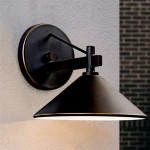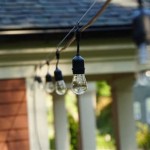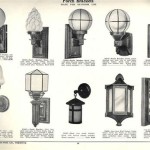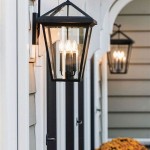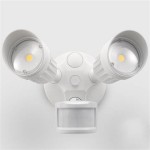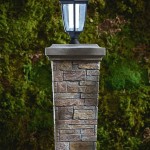Photocell Outdoor Lighting Control: Enhancing Safety and Efficiency
Outdoor lighting is crucial for security and safety in residential, commercial, and public spaces. However, constantly switching lights on and off manually can be inconvenient and wasteful. Photocell outdoor lighting control systems offer a convenient and efficient solution, automatically adjusting outdoor lighting based on ambient light levels. By using a photocell sensor, these systems ensure that lights are only activated when needed, maximizing energy efficiency and extending the lifespan of bulbs.
How Photocell Outdoor Lighting Works
Photocell outdoor lighting control systems function by utilizing a light-sensitive sensor, also known as a photocell or cadmium sulfide (CdS) cell. These sensors are typically mounted on the fixture or nearby, exposed to ambient light conditions. When the light level falls below a pre-determined threshold, the photocell activates the connected lighting fixture. Conversely, when the light level rises above the threshold, the photocell deactivates the fixture. This process creates an automatic on-off cycle, eliminating the need for manual intervention.
The sensitivity of the photocell can be adjusted to accommodate different lighting requirements. For example, a higher sensitivity setting will activate the lights at dusk, while a lower sensitivity setting might only activate them at night. This customization allows for tailored lighting schedules based on specific needs and preferences.
Benefits of Photocell Outdoor Lighting Control
Photocell outdoor lighting control systems provide numerous benefits for homeowners, businesses, and public entities. These advantages include:
Enhanced Safety and Security
By automatically illuminating outdoor spaces during darkness, photocell lighting systems enhance safety and security. These systems help deter criminal activity by providing visibility and discouraging potential intruders. Additionally, they can illuminate walkways, stairs, and driveways, minimizing the risk of accidents and falls.
Energy Efficiency and Cost Savings
Photocell lighting systems promote energy efficiency by only activating lights when necessary. This eliminates unnecessary energy consumption during daylight hours, reducing electricity bills substantially over time. The reduced energy consumption also contributes to environmental sustainability by decreasing carbon emissions.
Increased Bulb Lifespan
By preventing the unnecessary use of bulbs during daylight hours, photocell lighting systems extend their lifespan. This eliminates the need for frequent bulb replacements, saving both time and money. Increased bulb lifespan translates to reduced maintenance costs and less waste disposal.
Convenience and Automation
Photocell lighting control systems automate the lighting process, eliminating the need for manual intervention. This convenience is particularly beneficial for individuals who are unable to reach outside light switches or who simply prefer the ease of automated lighting. The systems seamlessly adapt to changing light conditions, ensuring optimal lighting levels at all times.
Types of Photocell Outdoor Lighting Systems
Photocell outdoor lighting control systems are available in various configurations to accommodate diverse lighting needs. Common system types include:
Standalone Photocells
Standalone photocells are compact sensors that can be easily installed on existing light fixtures. These self-contained units typically come with a built-in dusk-to-dawn timer and a photocell sensor, offering a simple and cost-effective solution for automatic lighting control.
Integrated Photocells
Integrated photocells are incorporated directly into the light fixture's design. This provides a seamless and aesthetically pleasing solution, eliminating the need for separate wiring and installation. Integrated photocells are often found in modern outdoor lighting fixtures.
Smart Home Integration
Some advanced photocell systems can be integrated with smart home automation systems. These systems allow for remote control and customization of lighting settings through mobile apps or voice assistants. This integration provides enhanced control and flexibility, enabling users to adjust lighting schedules and preferences based on their needs.
Installation and Maintenance
Installing photocell outdoor lighting systems is generally straightforward, but it is recommended to consult with a qualified electrician for professional installation. The process typically involves connecting the photocell to the lighting fixture's wiring and adjusting the sensor's sensitivity. Maintenance is minimal and usually involves cleaning the sensor to ensure optimal performance.
Conclusion
Photocell outdoor lighting control systems offer a convenient, efficient, and economical solution for enhancing safety, security, and energy savings in outdoor spaces. By automatically adjusting lighting based on ambient light levels, these systems provide numerous benefits for homeowners, businesses, and public entities. Whether opting for standalone photocells, integrated systems, or smart home integration, photocell lighting control offers an effective way to optimize outdoor lighting for safety, efficiency, and convenience.

Photocell Outdoor Lighting Control 866 637 1530

Hardwire Post Eye Light Control With Photocell Automatic Sensor Switch Ledwholers

120v Outdoor Swivel Mount Light Control Photocell

Photocell Indoor Outdoor Post Eye Light Control 120v

Hardwire Post Eye Light Control With Photocell Automatic Sensor Switch Ledwholers

Woods 59413wd Outdoor Conduit Lighting Control With Photocell And Swivel Mount Black Com

Mini Type Outdoor Conduit Lighting Control With Photocell China Photo Sensor Made In Com

Ip54 Outdoor Light Sensor Switch Photocontrol China Photocell Control Made In Com

Amicismart Automatic On Off Street Light Switch Controller Ac 220v 10a Photocell Sensor For Outdoor Lights Smart In Buy

Design House Gray Motion Light Sensor Adapter 1800 Watt Stem Mount Outdoor Control With Photocell Ul Listed Hardwired Dusk To Dawn On Off In The
Related Posts
